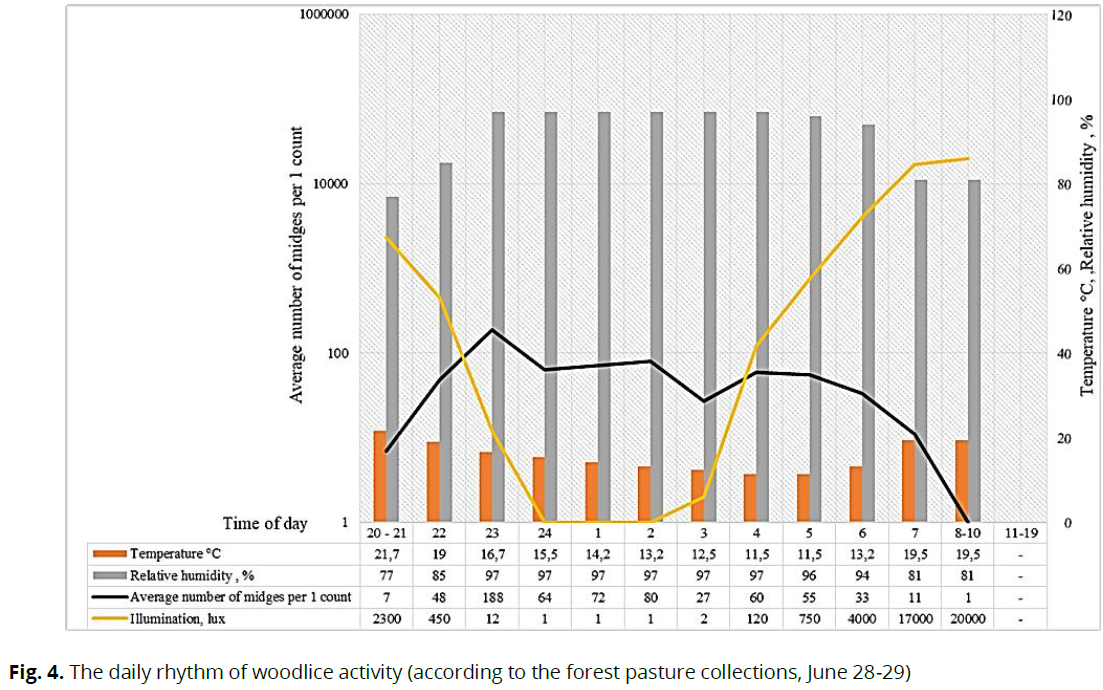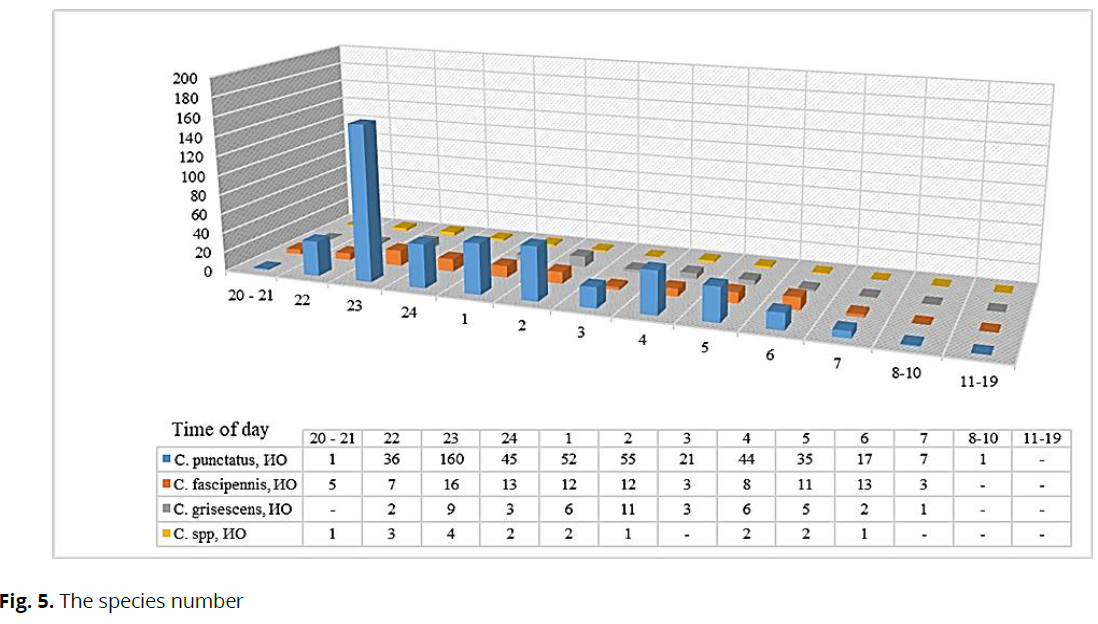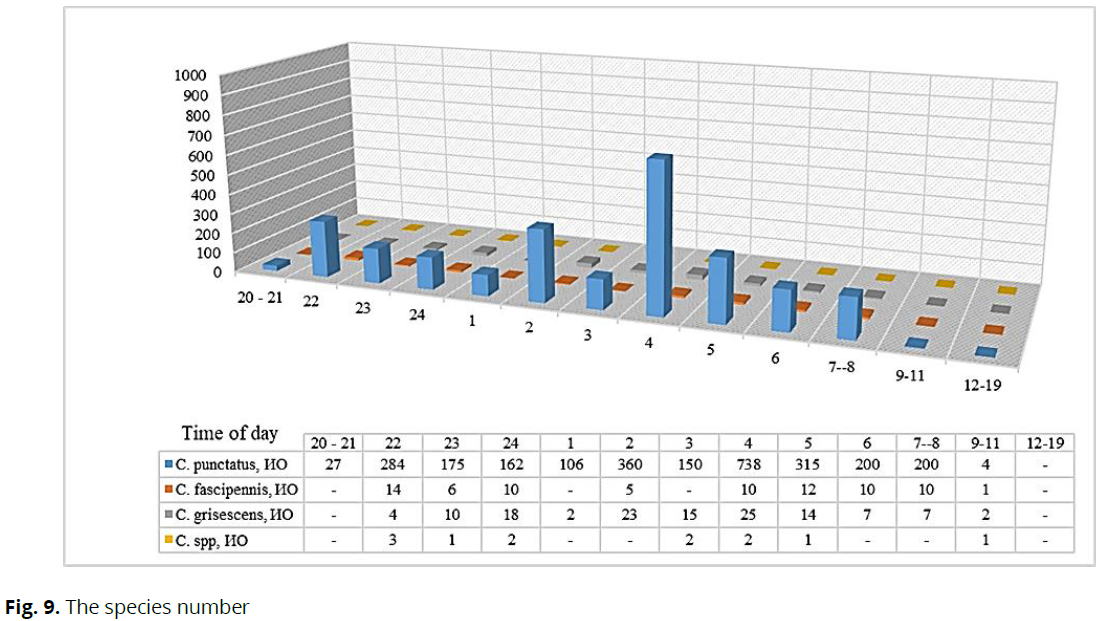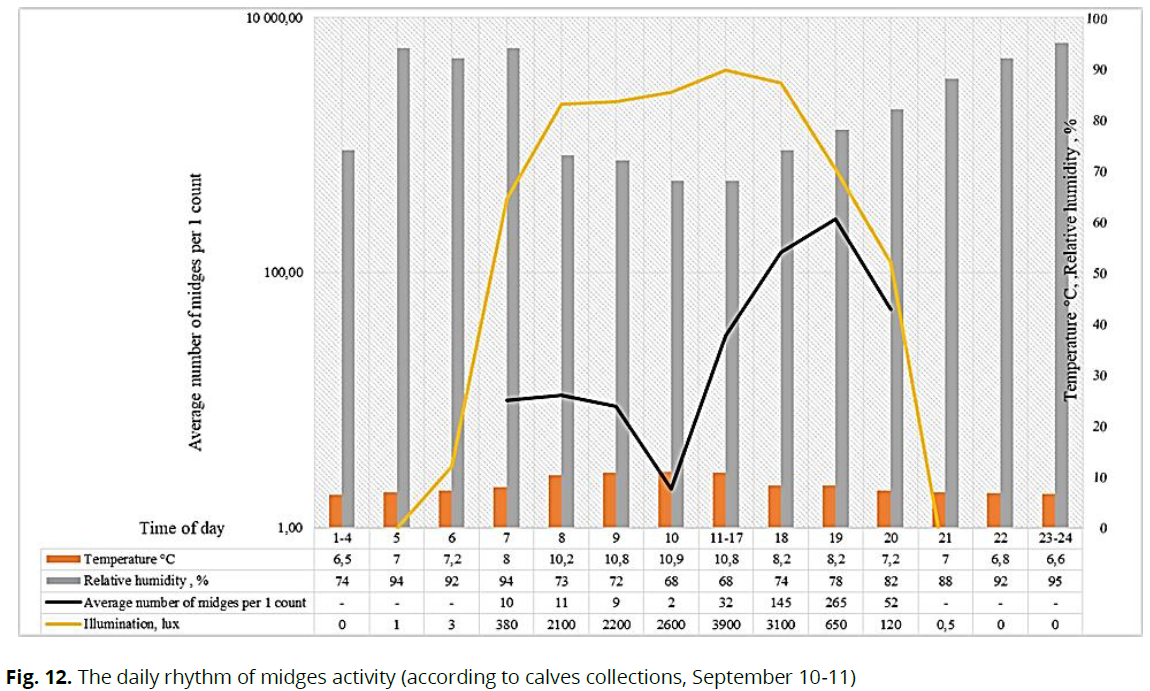Research Article - (2021) Volume 11, Issue 2
Dynamics of daily activity of blood-sucking biting midges in the south of the Tyumen region
O.A. Fiodorova*, M.I. Serkova and T.E. SavchukAbstract
Here we presented the results of studies conducted in 2017 on the daily activity rhythm of blood-sucking midges (Diptera, Ceratopogonidae) in the south of the Tyumen region. We used an entomological landing net with removable bags at intervals of 1 hour for collecting and counting biting midges. At the same time, temperature, relative humidity, wind speed, and precipitation were recorded. The identification tables were used to determining the species of the imago of blood-sucking biting midges; the species name was presented following the current accepted list. The maximum activity of biting midges was observed in the morning and evening; the peak of species diversity was observed at 2 AM, 3 AM, 7 AM, and 10 PM. When studying the daily rhythm, an attack of 13 species of blood-sucking midges of the family Ceratopogonidae, belonging to the same genus Culicoides, was recorded. During the study period, the dominant species was Culicoides punctatus, while C. fascipennis and C. grisescens were inferior to it in number; C. obsoletus, C. chiopterus, and C. gornostaevae, were rarely recorded. The study of the distribution of biting midges is currently relevant since they are vectors of animals and humans' infectious and invasive diseases.
Keywords
biting midges, species diversity, the daily rhythm of activity, air temperature.
Introduction
Biting midges (Diptera, Ceratopogonidae) are small dipterous insects that are part of the complex "gnats" and have a wide distribution in Russia's territory. The harmful significance of these is that females of some species are vectors of infectious and invasive diseases such as Rift Valley fever, blue tang, tularemia, onchocerciasis, Schmalenberg disease (Burova et al., 2018; Fall, 2015a, Glukhova, 1989; Sprygin et al., 2015, 2016), which affect wild and domestic animals all over the world, inflicting economic damage to agriculture.
In the literature available to us, both in Russian and foreign, there is no complete picture of analytical studies on biting midges' daily activity (Diptera: Ceratopogonidae) since the research was carried out in 60-80 years of the last century. Even though biting midges (Diptera: Ceratopogonidae) are mass bloodsuckers in some regions of Siberia and the Far East, dynamics of their activity in Russia (Burylova, 1966; Glukhova, 1956, 1986; Glushchenko, 1969; Mirzaeva, 1963; Ostroushko, 1967, Sprygin, 2020) and in countries far abroad is still little studied (Sanders 2011, Viennet 2012).
The daily activity of biting midges depends mainly on the environment's meteorology - air temperature, relative humidity, precipitation, speed of light. According to literature and research, the biting midges show the most activity in the morning and evening. Low temperature is the main limiting factor affecting the activity of the biting midges. Conducted studies on meteorological conditions showed that the biting midges are most active at a temperature in the range of from12-16 °C, the relative humidity of 8-95%, and wind speed of less than 1.0 m/s. Increased wind speed disrupts odor and carbon dioxide flows that the victim emanates and suppresses insects' activity (Burylova, 1966; Glukhov, 1956, 1986; Fall 2015b).
The increase in morning flying was associated with an increased temperature of 26 °C and decreased relative humidity. In the evening, the biting midges are most active at high humidity and temperatures from 20 to 25 °C depending on the season (Viennet 2012, Yanzhieva et al., 2018, Fedorova et al., 2017).
Blood-sucking biting midges can be found throughout the Tyumen region's territory; however, their activity depends on the season and environmental conditions; thus, the biting midges' daily activity has some particularities.
Our research aimed to investigate the particularities of daily activity of different blood-sucking biting midges in the south of the Tyumen region.
Materials and Methods
The study of daily activity of blood-sucking biting midges (Ceratopogonidae family) was carried out during the summer season in June-July 2017 in pastures and cattle farms in the southern part of the Tyumen region, on the territory of the village of Velizhany, Nizhnetavdinsky district (near the northern border of the subzone of the hornet and birch forests of the forest zone, 57°3312.321" N; 65°45'8.124 "E) (Zapadnajasibirj, 1963; Tarassenkof, 1964; Atlas…, 1971). According to the generally accepted method, counting of biting midges was carried out during the day every hour 2 times a month - Entomological net with removable bags. (Rasnitsyn, 1979) The time between the countings was one hour. Each counting consisted of 2-3 repetitions. Simultaneously, meteorological conditions were recorded: temperature, relative humidity, wind speed, illumination level. The determination tables of Gutsevich (1973) Mirzaeva (1989), and Glukhova (1989) were used to confirm the species composition of the biting midges (Fig 1).

Fig 1: Research site - Velizhany village.
Results
As a result of the conducted studies, it was established that during the summer season, daily activity of biting midges varies depending on the environment, which is revealed for the period of June-July, which shows evening, night, or morning upturns in numbers and daytime decrease in the quantity of biting midges. As can be seen from Figs. 2-5, in the daily records conducted on 16-17 and 28-29 of June, the biting midges attacked in the hours from 8-9 PM to 8-10 AM. In the afternoon, from 10-11 AM to 7 PM, the biting midges were not found in the countings. The maximum activity of biting midges in June was observed at 10– 11 PM (188-394 insects registered per counting) and 7 AM (2695 insects registered per counting). At the optimum air temperature +12... +14 °. From June 28-29, the biting midges flew all night (their quantity reached the maximum at 2 AM). At an air temperature of +5.8... +7.4 °C at night of June 16-17, biting midges flew, but their numbers were lower than at 7 AM during the activity maximum.

Fig 2: The daily rhythm of woodlice activity (according to collections from the forest pasture, June 16-17)

Fig 3: The species number

Fig 4: The daily rhythm of woodlice activity (according to the forest pasture collections, June 28-29)

Fig 5: The species number
When the temperature drops to 5.7 — 7.4° C, the number of biting midges decreased. During the counting period in June, peak activity was recorded in the morning from 6 to 7 AM (2697 individuals per counting) and 10 PM (395 individuals per counting). During the daytime from 10-11 AM to 7 PM, no biting midges were found due to increased illumination.
In July, daily activity studies were carried out on two stations: forest pasture and the village's outskirts near the farm. The results of these countings are presented in Figures 6 and 9. During the month, the biting midges attacked in the period from 9 PM to 8 AM. In the countings of 13-14 and 25-26 July, the biting midges were not registered during the day before 8 PM. The maximum activity of biting midges in July was observed at 2-3 AM (125 - 726 individuals per counting) or 5 AM (118-723 individuals per counting), as well as at 10–11 PM (140 - 335 individuals per counting).

Fig 6: The daily rhythm of woodlice activity (according to the forest pasture collections, July 14-15)

Fig 7: The species number

Fig 8: The daily rhythm of woodlice activity (according to the forest pasture collections, July 25-26)

Fig 9: The species number
The most significant biting midges were observed after sunset and before dawn at illumination from 1 to 6000 lux, air temperature of 13-14 ° C, and wind speed of 0.2-0.5 m/s. The cattle attack was recorded throughout the day with a significant decrease at the light from 9 to 22000 lux.
From the second decade of August to September, there are pronounced fluctuations in temperature that go beyond the optimum at night and reduce the light period, which entails a change in the daily rhythm nature of the biting midges activity. Under these conditions, the morning and night attacks get reduced, the peak of activity shifts to the daytime. There emerge other periods of biting midges' flight throughout the day, when there is a shift in activity towards daytime, and there are no attacks at night since the temperature is not optimal. Data on daily countings conducted on 19-20 August and 10-11 September show that in August, the biting midges attack in the morning from 6:30 AM and the evening from 7-9 PM, the rest of the time there is no flying (Figs. 10-13). The daily counting, conducted on September 10, under clear weather conditions, showed the absence of flying at night. The insects began to fly only in the morning, starting from 7:30 AM at a temperature of 6.2 °C, and continued to fly until 8:30 PM, but showed low numbers in the afternoon. The total collection was 365 insects at 7 PM and a temperature of +8.2 °C.

Fig 10: The daily rhythm of midges activity (according to calves The daily rhythm of woodlice activity (according to the forest pasture collections, August 19-20)

Fig 11: The species number

Fig 12: The daily rhythm of midges activity (according to calves collections, September 10-11)

Fig 13: The species number
Thirteen species of the same genus Culicoides Latreille have been recorded during daily countings of biting midges. The dominant species during the research period was Culicoides punctatus Meigen at temperatures ranging from +5.8 to +28.4 °C, turning out to be the most cold-resistant. The C. fascipennis Staeger and C. grisescens Edwards proved to be the most heat- loving, starting to fly at +6.2 oC; they were found even at +28.4 °C; C. obsoletus Meigen, C. chiopterus Meigen (C. dobyi Kallot et Kremer), C. gornostaevae Mirzaeva, C. pulicaris Linnaeus, C. subfascipennis Kieffer, C. pallidicornis Kieffer, C. reconditus Campbell et Pelham-Clinton, C. manchuriensis Tockunaga, C. nubeculosus Meigen, and C. stigma Meigen were also registered, but were less abundant and combined into C. spp.
Discussion
Thus, the obtained data indicate that the main factors determining the nature of the daily rhythm of activity of blood-sucking biting midges in the south of the Tyumen region are temperature and light. The primary determinative importance of these periodically active factors on insects' daily activity, on the example of mosquitoes, was established by A. S. Monchadsky (1946, 1958), and according to his studies, light is the main regulating factor of the daily rhythm of activity. The temperature within the optimum range determines the quantitative side. These patterns were confirmed by V.M. Glukhova (1956,1989) for blood- sucking biting midges in the territory of Karelia (northern taiga), which is characterized by white nights. Depending on the variations in light level and temperature, she defines five types of the daily rhythm of the biting midges' activity.
At the beginning of the flying with round-the-clock light, the first two types were observed.
I. Numerically high attacks were during the day (in the evening, throughout the night, and in the morning). In daylight, there are no attacks due to the high level of illumination.
II.Morning and evening rise in quantity alternate with the afternoon (due to high light levels) and night (due to low temperatures) absence of attacks.
In the second half of the flying, when the nights turn dark, the following two types of the daily rhythm of activity can be observed.
III. Morning and evening rise in numbers alternate with afternoon and night (due to darkness) lack of attacks. There are attacks at night during peak seasonal activity if the temperature is optimal, however not very intense.
IV. Similar to type I, the number of biting midges at night is low and caused by moonlight.
V. This type of daily rhythm is characteristic of autumn. Simultaneously, high evening and minor late morning rise in numbers alternate with night absence (due to the darkness and low temperature) and minor afternoon attacks under favorable temperature conditions and low autumn illumination.
It is known that the forest zone is characterized by two types of the daily rhythm of biting midges' activity: II and V (Burylova, 1966; Glukhova, 1956, 1986; Glushchenko, 1969; Mirzaeva, 1963; Ostroushko, 1967).
According to our data, in the conditions of the south of the Tyumen region, where there is no round-the-clock light, in June-July, the III and IV types prevail, and August - September are characterized by the III and V types of the daily rhythm of activity. Thus, in the conditions of the south of the Tyumen region, there are three types of the daily rhythm of biting midges' activity during the summer-autumn period.
The study of daily activity and particularities of the behavior of blood-sucking biting midges when attacking animals allows us to conclude that the use of insecticides of acute action in the fight against these insects promises for rapid one-time reduction of numbers during the hours of maximum daily activity during bulk herd/cattle treatments.
Conclusions
When studying the dynamics of the daily rhythm of biting midge activity in the south of Tyumen oblast, three types of activity were recorded throughout the day - morning and evening alternating with daytime at 7:00, and at 2-3 or 5 and 22:00. The species diversity of attacking blood-sucking biting midges falls on the peak of their numbers. Thus, the data obtained indicate that the main factors determining the nature of the daily rhythm of blood-sucking biting midges in the south of the Tyumen region are temperature and illumination. The nature of the daily rhythm of biting midge species' activity depends on the species' ecological characteristics, the number during the research season, and the optimal meteorological conditions optimal for active flight.
Acknowledgments
The article was prepared with financial support within the framework of the topics of FR No. 296-2021-0018 - Study and analysis of the epizootic state of diseases of invasive etiology of agricultural and unproductive animals, bees, and birds, changes in the species composition, and bioecological patterns of the development cycle of parasites in conditions of displacement of the boundaries of their ranges.
References
Burova, O. A., Blokhin, A. A., Zakharova, O. I., Yashin, I. V., Liskova, E. A., Gladkova, N. A. (2018). Vectors of transmissive viral diseases of animals. Agrarian Science of the Euro-North, 5(66), 4-17.
Burylova, A.M. (1966). Fauna and ecology of blood-sucking woodlice (Diptera, Heleidae) Perm Region. Thesis of Doctoral Dissertation. Perm
Fall, M., Fall, A.G., Seck, M.T. (2015a). Host preferences and circadian rhythm of Culicoides (Diptera: Ceratopogonidae), vectors of African horse sickness and bluetongue viruses in Senegal, 49, 239– 45.
Fall, M., Fall, As. G., Momar, T. (2015b). Cardian activity of Culicoides oxystoma (Diptera: Ceratopogonidae), potential vector of bluetongue and African horse sickness viruses in the Niayes area Senegal. Parasitology Research, 114(8), 3151-3158
Fedorova, O. A., Khlyzova, T. A., Sivkova, E. I., Savchuk, T. E. (2017). Summer dates of blood-sucking woodlice (Diptera, Ceratopogonidae) in the aspen-birch forest subzone of the south of the Tyumen region. Bulletin of meat cattle breeding, 1(97), 141–145.
Glukhova, V. M. (1956). Fauna and ecology of woodlice (Culicoides) Karelia-Finnish SSR. Thesis of Doctoral Dissertation. Petrozavodsk.
Glukhova, V. M. (1989). Blood-sucking woodlice of the genera Culicoides Forcipomyia (Ceratopogonidae). Fauna of the USSR. Insects. Diptera. Vol 3. Leningrad. Nauka. Leningrad Branch.
Glushchenko, N. P. (1966). Fauna and ecology of blood-sucking woodlice (Diptera, Ceratopogonidae) of the upper Lena River basin. Thesis of Doctoral Dissertation. Tomsk.
Gurtsevich, A.V. (1973). Blood-sucking woodlice (Ceratopogonidae). Fauna of the USSR. Diptera. Moscow. Nauka, 3 (5), 269. Mirzaeva, A. G. (1963). Blood-sucking woodlice (Heleidae) of the southern taiga of the Ob region. Thesis of Doctoral Dissertation Mirzaeva, A. G. (1989). Blood-sucking woodlice (Diptera, Ceratopogonidae) of Siberia and the Far East. Novosibirsk: Nauka Monchadsky, A. S. (1946). Attack activity and its diurnal rhythm in the mosquito Mansonia richiardii Fic. Izvestiya AN USSR, 2(3),299-323.
Monchadsky, A. S. (1958). On the classification of environmental factors. Zoological Journal. 37(5), 680-692. Ogorodnov, E. A. (1971). Atlas Tyumenskoj oblasti (The Atlas of Tyumen Region). 1. Tyumen.
Ostroushko, T. S. (1967). Blood-sucking woodlice (Diptera: Ceratopogonidae) of the taiga part of the Northern Urals. Parasitology, 1(1), 41-46.
Rasnitsyn, S. P., Kosovskikh, V. P. (1979). An improved method of accounting for the abundance of mosquitoes with a net around a person and comparing it with the dark bell. Medical parasitology and parasitic diseases, 1, 18–24
Sanders, Chr. J., Shortall, Chr. R. (2011). Gubbins S. Influence of season and meteorological parameters on flight activity of Culicoides biting midges. Journal of Applied Ecology, 6, 48, 1355–1364
Sprygin, A.V., Bellis, G. A., Pavelko, V. I., Pasunkina, M. A., Kononov, A.V. (2020). Seasonal activity of female midges of the genus
Culicoides (Diptera: Ceratopogonidae) in various regions of the Russian Federation. Parasitology. 54 (3), 231-246.
Sprygin, A. V., Fiodorova, O. A., & Babin, Y. Y., Pavelko, V., Bellis, G., Kononov, A. (2016). The fluctuations of seasonal population of Culicoides midges in the Smolenskay, Pskovskaya and Vladimirskaya provinces of Western Russia in 2013. Veterinaria Italiana, 52 (3-4), 231-234
Sprygin, A. V., Fiodorova, O.A., & Babin, Y. Y., Kononov, A. V., Karaulov, A. K. (2015). Blood-sucking midges (Diptera: Ceratopogonidae) and their role in spreading blue tongue and Schmallenberg diseases in Russia. Agrobiology, 50(2), 183- 197.
Tarasenkov, G.N. (1964). Na otkrytyh prostranstvah rek Ob' i Irtysh (Priroda, byt i kul'tura Tyumenskoj oblasti). [On open spaces of Ob and Irtysh rivers. Nature, household, and culture of Tyumen region]. Moscow.
Viennet E., Garros, C., Rakotoarivonv, I. (2012). Host-Seeking Activity of Bluentogue Virus Vectors: Endo/ Exophagy and Circadian Rhythm of Culicoides in Western Europe. PloS one, 7(10), Article no: e48120.
Yanzhieva, D. V., Murueva, G. B. (2018). Mokretsy as vectors of the sheep Bluetongue virus. Bulletin of the Buryat State Agricultural Academy named after V. R. Filippov. 2 (35), 24–28.
Author Info
O.A. Fiodorova*, M.I. Serkova and T.E. SavchukCitation: Fiodorova, O.A., Serkova, M.I., Savchuk, T.E. (2021). Dynamics of daily activity of blood-sucking biting midges in the south of the Tyumen region. Ukrainian Journal of Ecology, 11 (2), 159-168.
Received: 17-Feb-2021 Accepted: 24-Mar-2021 Published: 31-Mar-2021, DOI: 10.15421/2021_94
Copyright: This is an open access article distributed under the terms of the Creative Commons Attribution License, which permits unrestricted use, distribution, and reproduction in any medium, provided the original work is properly cited.
